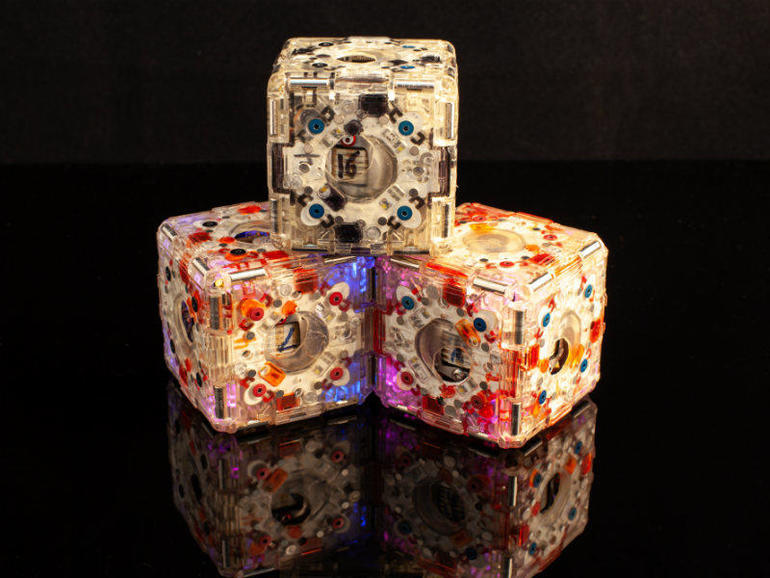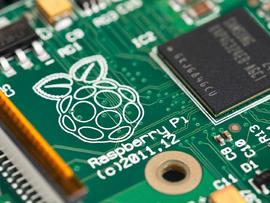The modular M-Blocks can intercommunicate, climbing over and around each other.
MIT's Computer Science and Artificial Intelligence (AI) Laboratory announced in a paper on Wednesday its creation of self-assembling robots. The cube-shaped robots, referred to as M-Blocks, can climb over and around each other, jump in the air, and roll on the ground.
The paper titled, "Decentralized Control for 3D M-Blocks for Path Following, Line formation, and Light Gradient Aggregation," detailed the functionality of the modular self-reconfigurable robots. The group of 16 autonomous robots move independently, but are able to virtually identify fellow robots in the vicinity. Once virtually connected, each robot can move along a structure built out of the robots themselves, or regular blocks, said CSAIL PhD student John Romanishin, lead author on the paper.
SEE: Internet of Things: Progress, risks, and opportunities (free PDF) (TechRepublic)
"We've developed several algorithms wherein they can do simple tasks," Romanishin said. "One of the tasks is that you put a bunch of robots into a random shape, they can transform into a line, follow arrows, or move along a path."
The robots are able to recognize each other with a barcode-like system on each face of the block that enable the robots to identify, the paper said. Each M-Block moves at 20,000 revolutions per minute using angular momentum, and each side on every face has permanent magnets that allow the cubes to attach to each other.
Self-assembling robots are "small robots that can form structures together. And that full structure are the robots self-assembled," said Romanishin. "People seem to think they're robots that build themselves from pieces, which is a valid way of thinking about the term self-assembly, but that's not what people mean in the robotics field."
Previous modular robot systems
Other
modular robots use unit modules with small robotic arms, or external
actuators, to move, the paper noted. Those systems, however, demand a
large amount of coordination for simple movements like jumping or
hopping.
With communication, previous attempts used infrared
lights or radio waves, but if you have many robots in a small area,
these signals can conflict.
The MIT team instead created a cube devoid of arms, using inertial forces to move the robots. These forces are the result of a mass inside each cube that throw themselves against the side of the module, causing the block to rotate or move in 24 different directions, with there being six faces, the paper added.
"There's a relatively large field of other people building sort of similar robots," Romanishin said, "But the two main unique parts about our robots are how they move, which is using angular momentum from what we call a reaction wheel, and the way it uses magnets. It uses them in a special way that is potentially a really scalable and cheap solution for identifying hundreds of thousands of elements in a small space."
"One of the big things that we looked at was how do you make the robots move relative to each other? It's a really challenging, from a design standpoint and a physics standpoint," Romanishin added. "Our system was one of the first that used angular momentum and moved modules. That has advantages compared to other approaches because it's a lot simpler."
Looking ahead
The M-Blocks are still in the very early stages, a long way from practical, widespread use, Romanishin said.
Future applications could make a significant impact. However. One vision would be using the robots to build a temporary bridge during a flood, or a temporary staircase to rescue people from a burning building, Romanishin noted.
These applications could prove invaluable particularly in natural disasters, where a cheap, temporary option is needed for unpredictable circumstances.
"Originally, we wanted to build a hundred or a thousand, but it turns out that with parent technology that's really expensive," Romanishin said. "We're still excited to have a system of modules that work and that we can run experiments with."
Even though the technology is in its early stages, autonomous robots are being developed, and MIT's M-Blocks are a clear step in that direction.
For more, check out the Top 5 ways robots affect your life on TechRepublic.
Also see
- IT leader's guide to deep learning (TechRepublic)
- Telemedicine, AI, and deep learning are revolutionizing healthcare (TechRepublic download)
- Managing AI and ML in the enterprise 2019: Tech leaders expect more difficulty than previous IT projects (TechRepublic Premium)
- What is AI? Everything you need to know about Artificial Intelligence (ZDNet)
- 6 ways to delete yourself from the internet (CNET)
- Artificial Intelligence: More must-read coverage (TechRepublic on Flipboard)










